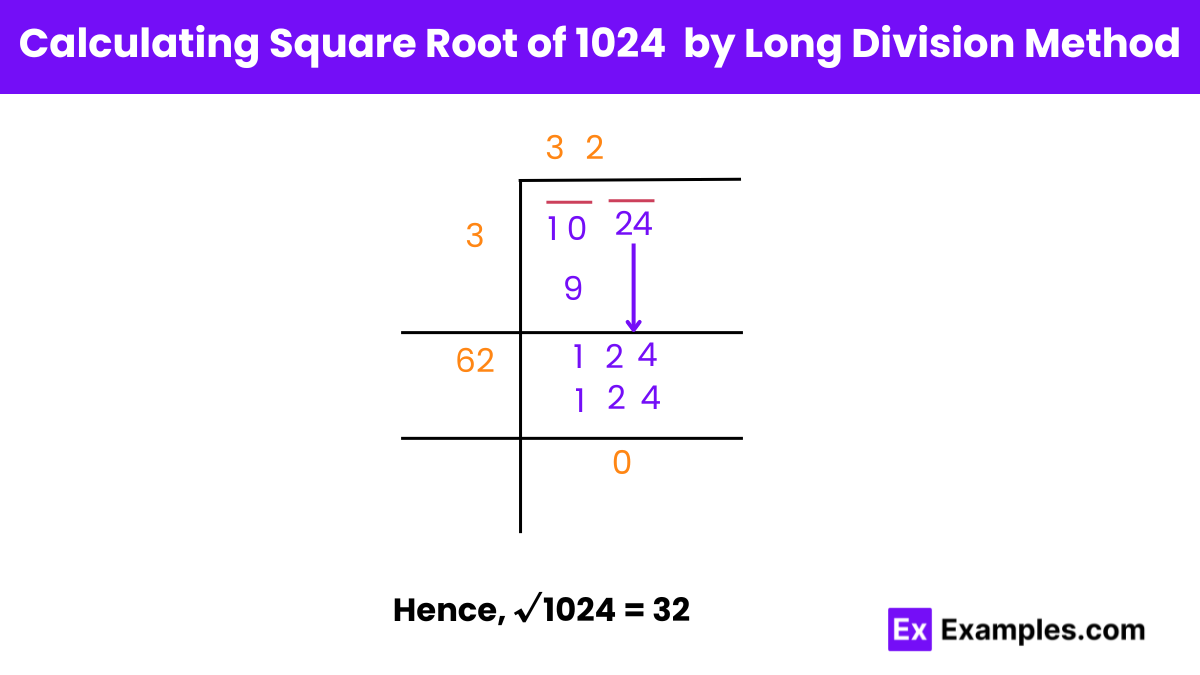square & square root of 1024
Square of 1024
The square number of 1024 is 1,048,576, which means multiplying 1024 by itself, resulting in a large number with seven digits.
Square Root of 1024
The square root of 1024 is 32. It’s the value that, when multiplied by itself, equals 1024. In mathematical notation, it’s √1024 = 32. This value is useful in various contexts, such as calculating dimensions or understanding geometric properties in mathematics and engineering.
Square Root of 1024: 32
Exponential Form: 1024^½ or 1024^0.5
Radical Form: √1024
Is the Square Root of 1024 Rational or Irrational?
A rational number is any number that can be expressed as the quotient of two integers, where the denominator is not zero. This category encompasses integers, fractions, and decimals that either terminate or repeat.
Conversely, an irrational number is a real number that cannot be represented as the ratio of two integers. In other words, it cannot be expressed as a fraction where both the numerator and denominator are integers.
The square root of 361, upon calculation, yields an irrational number. This is because it cannot be simplified into a fraction of two integers. The decimal representation of the square root of 361 neither repeats nor terminates, distinguishing it from rational numbers which have finite or recurring decimal expansions.
Therefore, the square root of 361 falls outside the realm of rational numbers due to its inability to be expressed as a fraction of integers, hence it is considered irrational.
Methods to Find Value of Root 1024
There are several methods to find the square root of 1024:
- By Hand Calculation: Using long division or other manual methods, such as the digit-by-digit method or the Babylonian method.
- Using a Calculator: Modern calculators can provide the square root of a number instantly.
- Using a Computer Program: Writing a simple program in a language like Python or using built-in functions in programming languages like
sqrt()in Python orMath.sqrt()in JavaScript. - Estimation Methods: Utilizing estimation techniques, such as the Newton-Raphson method or successive approximation.
- Prime Factorization: Breaking down 1024 into its prime factors (2¹⁰), then dividing the exponent by 2 to get the square root (10/2 = 5), resulting in 2⁵ = 32.
- Using Tables or Reference Materials: Consulting mathematical tables or reference materials that provide pre-calculated square roots.
These methods vary in complexity and speed, but all can be used to find the value of the square root of 1024.
Square Root of 1024 by Long Division Method

Certainly! Here’s a clearer, step-by-step explanation of how to manually calculate the square root of 1024 using the traditional long division-like method:
Step 1: Grouping digits
Group the digits of the number (1024) in pairs from right to left. So, we pair them as (10) and (24).
Step 2: Find the largest square less than or equal to the first group
Identify the largest integer Y whose square is less than or equal to the first group (10). This number is 3, as (3²= 9) which is less than 10. Divide 10 by 3, giving a quotient of 3.
Step 3: Bring down the next pair
Take down the next pair of digits, which is 24, next to the remainder 1, making it 124.
Step 4: Update the divisor
Add the last digit of the quotient (3) to the divisor (3), which gives (3 + 3 = 6). Find a digit Z such that (62Z) is less than or equal to 124. The digit Z is 2 since (62×2 = 124).
Step 5: Perform the division
Divide 124 by 62 with 2 as the quotient. The calculation (62×2=124) leads to a remainder of (124 – 124 = 0).
Step 6: Conclusion
Since the remainder is 0 and there are no more digits to bring down, we conclude the process. The calculated square root of 1024 is 32.
This method, also known as the square root algorithm, is similar to long division and helps find the square root of a number manually.
1024 is Perfect Square Root or Not
The number 1024 is not a perfect square root, but it is a perfect square. A perfect square is a number that can be expressed as the square of an integer. In the case of 1024, it is the square of 32, since (32 \times 32 = 1024).
A “perfect square root” would imply the square root of a number that results in an integer. Since the square root of 1024 is 32, which is an integer, we can say that 1024 has a perfect square root. However, the usual term used is simply that 1024 is a “perfect square” because it is the result of an integer squared.
FAQ’S
Square root of 1024 by prime factorization
Prime factorization of 1024 involves breaking it into its prime factors: 2¹⁰. So, the square root is 2⁵, or 32.
Can you use the square root of 1024 to find other roots?
Yes, knowing the square root, you can find higher roots by raising it to appropriate powers (e.g., cube root, fourth root).
What are the factors of 1024 square?
Factors of 1024 square are all pairs of numbers that multiply to 1024, resulting in perfect squares from 1 to 1024.
How does the square root of 1024 compare to other numbers?
It’s relatively easy to calculate due to its perfect square nature, making it useful in mental math and problem-solving.


